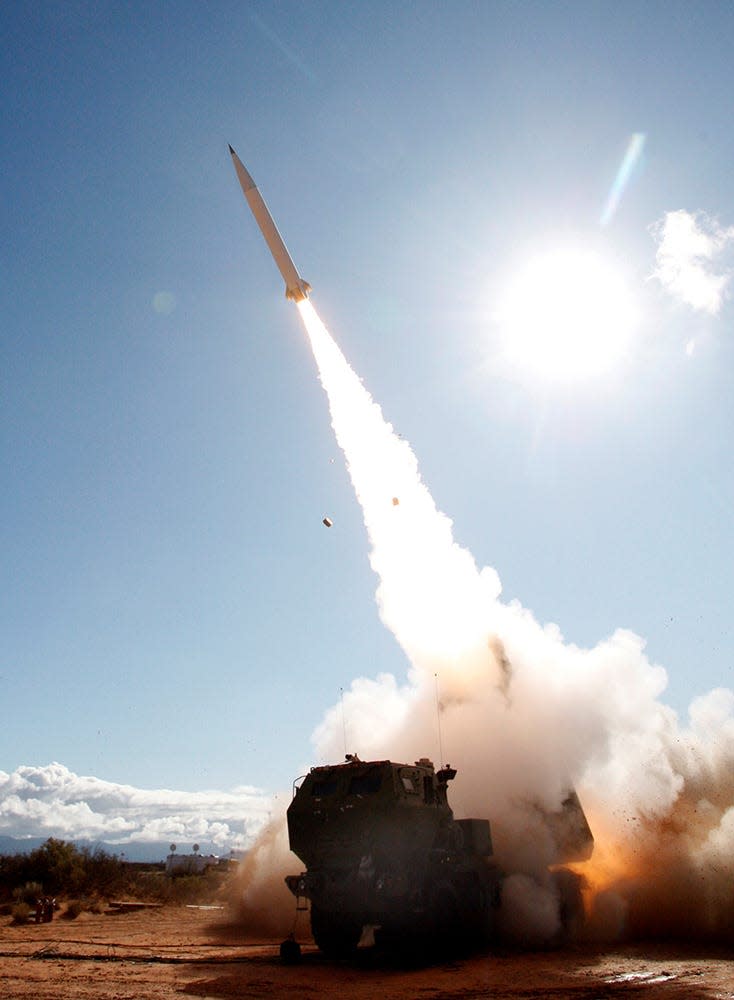US Army flight tested the seeker that will help turn its newest missile into a ship-killer

The US Army recently obtained its new Precision Strike Missile (PrSM), a surface-to-surface weapon.
Earlier this month, the Army revealed it made progress on a new variant of the ballistic missile.
It said it flight tested a seeker that will turn the PrSM into an anti-ship weapon.
The US Army has flight tested the seeker that will allow its newest missile to hunt down warships, among other targets.
Last month, the Army received its first delivery of the next-generation Precision Strike Missile (PrSM), a short-range, surface-to-surface ballistic missile. The baseline variant, called Increment I, is slated to eventually replace the country's inventory of powerful-but-aging MGM-140 Army Tactical Missile Systems, or ATACMS.
Future increments of this new missile developed by Lockheed Martin will focus on "increasing the range and engagement of time-sensitive, moving, hardened, and fleeting targets," according to a Pentagon evaluation document on the PrSM program.
Earlier this month, the Army revealed that it made progress on Increment II, which may be quite useful against fleeting targets. In a Jan. 2 reflection statement outlining its 2023 accomplishments, the Army said it "successfully" flight tested Land-Based Anti-Ship Missile (LBASM) multi-mode seeker technology that can be integrated into the PrSM.
"One of our biggest accomplishments this year has been the successful conclusion of our LBASM science and technology program, which will serve as the seeker for PrSM Increment Two," James Kirsch, director of the Army Combat Capabilities Development Command's Aviation & Missile Center, or DEVCOM AvMC, said.
"We are in the process of transferring that data to the project office and setting up future arrangements to continue providing the expertise they need," he added.
It is not clear when, exactly, these developments took place. DEVCOM AvMC did not immediately respond to Business Insider's request for additional details on the 2023 flight test.

A multi-mode seeker will allow the missile to hit moving targets like enemy air-defense systems and warships because it can hunt for radio frequencies and thermal imaging before homing in on a precise location, according to The War Zone, which first reported the Increment II developments on Tuesday.
The US military has anti-ship weapons in its arsenal, such as the Harpoon missiles that Ukraine has used to fend off Russia's invasion, but the Increment II PrSM would give the Army a boost in its maritime-targeting capabilities.
Anti-ship capabilities have shot into the limelight in recent months, largely due to the Houthis' relentless attacks on international shipping lanes off the coast of Yemen. The Iran-backed rebels boast a sizeable arsenal of anti-ship cruise and ballistic missiles, some of which have even managed to slam into commercial vessels transiting nearby shipping routes.
Degrading these capabilities through precision strikes has been a priority for the Biden administration over the past two weeks. On Tuesday, for example, US forces struck and destroyed four anti-ship ballistic missiles that the Houthis were preparing to launch.
Anti-ship weapons are, however, often a focus of great power competition. In the Western Pacific, for instance, they have become a growing concern for the US.
China, which was identified in 2022 as the "pacing challenge" for the US armed forces, has a variety of anti-ship ballistic and cruise missiles, and it is increasingly building up many of these capabilities.
China's anti-ship assets could threaten US forces in a conflict in the Indo-Pacific, as the maritime domain would likely be a key battlespace. Beijing has even built mock-ups of American warships — like the USS Gerald R. Ford aircraft carrier — that are suspected to be used for target practice.
But US rivals like China are not pursuing these lines of effort unchallenged, thus the work on American anti-ship capabilities across the services and the Army's bigger plans for its PrSM.
The PrSM can be fired from M142 High Mobility Artillery Rocket Systems, or HIMARS, and M270A2 Multiple Launch Rocket Systems. It's capable of performing in all weather conditions and can be outfitted with a cluster munitions payload, meaning it can disperse small bomblets over an area mid-flight, according to the Army's Acquisition Support Center.
The baseline variant will be able to engage targets at ranges greater than 250 miles, according to the center. Follow-on versions, it added, will focus on increased range, lethality, and engagement of moving and time-sensitive targets.
Assistant Secretary of the Army for Acquisition, Logistics and Technology Doug Bush said in December that the PrSM will provide leadership with a "24/7, all-weather capability that will counter the enemy's ability to conduct combat maneuver and air defense operations."
"The rapid development and delivery of this capability is a prime example of the Army's aggressive use of new acquisition authorities from Congress that allow us to move at much greater speed to get improved equipment to Soldiers," he said in a statement.
Read the original article on Business Insider

